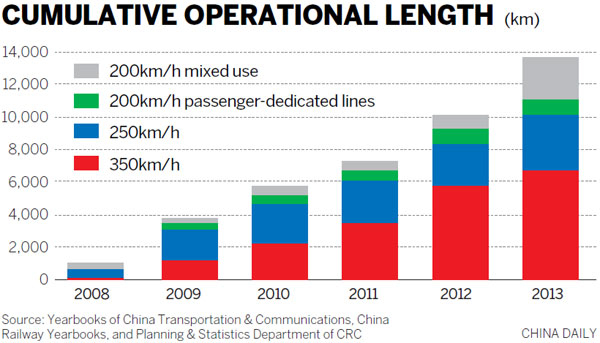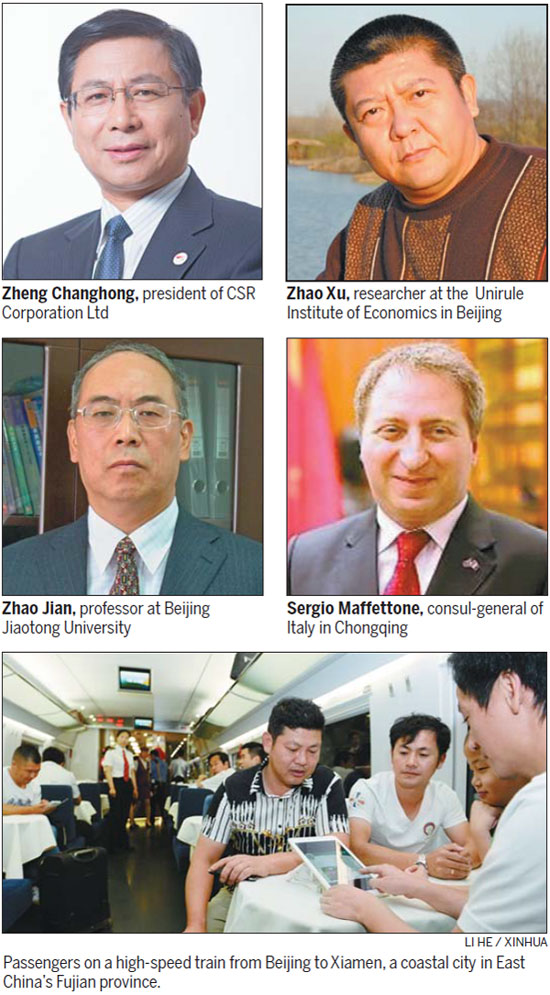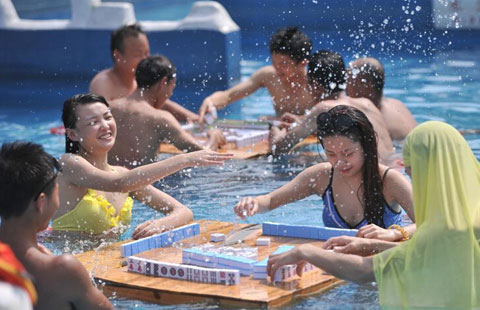Fast-tracking its success around the world
Updated: 2014-07-18 08:25
By Hu Haiyan (China Daily Europe)
|
|||||||||||
|
Two high-speed trains ready to roll out at Zhengzhou Railway Station in Central China's Henan province. Li An / Xinhua |

It is hard to credit that little more than seven years ago China had no high-speed rail network let alone any high-speed trains. Today, not only does the country have the world's largest high-speed rail network, covering more than 11,000 kilometers, but in little more than a year from now that will stretch to 18,000 km, and to 21,000 km by 2020.
As the frenetic pace of construction continues, a lot of it begun as part of the government's economic stimulus program after the 2008 financial crisis, the country's ever expanding fleet of ultramodern trains continues to dazzle the world and China is now pulling out all stops to promote and sell that technology internationally.
The state-owned rail operator China Railway Corp introduced new timetables on July 1 in an effort to cope with surging public demand.
The new schedule, which is the most significant change since 2007, brings the number of passenger trains in service to 4,894, of which 2,660 are high-speed trains running at speeds of more than 200 km/h.
The Beijing-Shanghai high-speed railway, the busiest route in China, has carried 220 million passengers over the past three years.
Given that the Chinese trains were built under technology transfers from French, German and Japanese companies, the sales song for China could well be Anything You Can Do (I Can Do Better). Indeed, whereas Japan's Shinkansen, France's TGV or Germany's ICE would have once dominated any chat about high-speed rail, these days China's system is likely to be at the forefront.
One of those heading the efforts to ensure the world knows about that prowess is Premier Li Keqiang, who has keenly promoted Chinese railway products and technology on his overseas trips, where he has stressed its modernity, reliability and safety.
Although there is obviously a lot of money to be made in selling such technology, national pride and the country's standing is also at stake. In fact in some cases China is giving away its technology free of charge.
"The export of China's high-speed train is far more than the economic returns," says Girma Temesgen, consul-general in Chongqing for Ethiopia. "It can also help build up good cooperation between China and other countries.
"Building high-speed rail can be a boon to developing nations like Ethiopia, helping them improve their transport infrastructure."
China has just started work on an electrified railway connecting Addis Ababa in Ethiopia and Djibouti.
Wang Mengshu, a tunnel and railway expert at the Chinese Academy of Engineering, says that as the Chinese high-speed railway network grows, the time is ripe for the country to export its technology and expertise.
"Switzerland is famed for its watches, Germany for its engineering and the United States for its aviation technology. When it comes to a pleasant trip on safe, comfortable high-speed trains, the world looks to China.
"Of all the country's total 100,000-km railways, about 11,000 km are high-speed ones, and it is expected that by 2020, the total length of the railway network will be expanded to 120,000 km, of which 21,000 km will be high-speed," says Wang.
One key advantage of Chinese high-speed train technology is that it is inexpensive, he says, and exporting it could speed up growth in developing countries.
Zheng Changhong, president of China's biggest train maker, CSR Corporation Ltd, says that while China's high-speed rail was developed first by absorbing foreign technologies, relying on its own research and development has been a key to its success.
"We learned the other countries' technologies and incorporated them into our own systems, and that was not easy," he says. "No other countries' high-speed rail network would encounter the problems China has had to deal with, given its size and greatly varied environmental conditions.
"With safety standards, I'm confident Chinese trains are as good, if not better than those of our Western competitors."
CSR, whose headquarters is in Beijing, produces diesel and electric locomotives, passenger and freight carriages, as well as rolling stock for subways and light rail systems.
The company is the world's largest manufacturer of electric locomotives, and had sales revenue of about 98 billion yuan ($15.67 billion; 11.3 billion euros) last year, an 8.21 percent rise on the previous year. Its profit was 4.139 billion yuan, 3.26 percent higher than the year before. It has exported trains and spare parts to 83 countries, including 20 in Europe.
"Taking China's high-speed rail global represents a huge market for domestic manufacturers," Zheng says.
From January to May the value of CSR's contracts overseas was 14.5 billion yuan, 87 percent higher than the year before, and accounted for a third of new orders.
"By 2020 we expect half of CSR's revenue will come from overseas," Zheng says.
The company is confident of its international competitiveness backed by strong technology, he says.
"Though we are latecomers, we are now in the leading position in the high-speed rail industry."
Zheng says more than 50 countries have expressed a desire to acquire technological support from China in developing high-speed rail development, and this represents a huge opportunity for Chinese manufacturers.
"More than a fifth of those countries said they hope they can work with CSR in terms of technology and products."
Other Chinese rail businesses are also scouting for customers overseas, and Zheng says CSR attaches great importance to that task.
Last month it signed a contract with the national railway company of Macedonia for six bullet trains, the company's first sale in Europe. In November, Chinese railway manufacturers displayed their wares in Romania, and they were seen by 16 leaders from Eastern Europe.
The previous month, Premier Li signed a memorandum of understanding with Thailand on railway construction, and in May in Africa he pledged that China would contribute to connecting all of Africa's capitals by high-speed rail.
During his visit to the UK in June, he is believed to have backed major UK infrastructure deals, including the country's 42.6 billion pound ($73 billion) High-Speed 2 fast train project.
Li offered direct help to build HS2 during Prime Minister David Cameron's visit to China last December, and CRC has also expressed an interest in construction projects connected to HS2, according to BBC.
China has also engaged in building high-speed rail in Turkey in a project worth $1.27 billion, Xinhua News Agency reported.
One factor that is helping drive China's overseas sales is its low costs. A World Bank report published this month said unit costs in building the high-speed rail network were lower than for similar projects in other countries.
"The high-speed rail network operates with high traffic volumes on its core corridors, and with good reliability. This has been accomplished at a cost which is at most two-thirds of that in the rest of the world."
Apart from lower costs of labor, another reason for the country's ability to build the network may be its scale, the report says.
"This has allowed the standardization of the design of various construction elements, the development of innovative and competitive capacity for manufacture of equipment and construction and the amortization of the capital cost of construction equipment over a number of projects," says the report.
While the country's still-young high-speed rail system has been extraordinarily successful, it has not run entirely without setbacks.
One of those occurred on July 23, 2011, when a high-speed train hit a stationary train near Wenzhou in Zhejiang province, killing 40 people. That accident cast a pall for a while, provoking a nationwide safety check, a reduction in speed limits and a slowdown in construction.
Wang of the Chinese Academy of Engineering, who directed an investigation of the accident, says poor traffic management was the main cause, rather than the quality of the hardware or the train traveling too quickly.
However, the accident has resulted in an improvement in railway system management and orders to ensure construction schedules that respect safety are adhered to, he says.
Zheng insists that Chinese rail "is very safe".
He adds that CSR-built high-speed trains have a derailment coefficient of 0.1, compared with the international standard of 0.8, the lower the number denoting a lower possibility of derailment.
Every year CSR spends more than 5 percent of its sales revenue on research and development. Last year that was 5.22 billion yuan.
"We are now experimenting with speeds of 650 km/h."
However, Zhao Jian, a professor at Beijing Jiaotong University who specializes in railways, says there is a big difference between Chinese engineers getting a high-speed rail system up and running at home and doing something similar in other countries.
"The differences in standards, laws and regulations are the challenges for China's high-speed railway companies wanting to set up overseas. In addition to that, building costs are very expensive.
"Rather than invest in high-speed railway networks overseas, China should focus on expanding the capacity of existing lines and increasing operating speeds."
However, Zhao Xu, a researcher at the Unirule Institute of Economics in Beijing, says it is essential for China's high-speed railway companies to go abroad even if many difficulties need to be overcome.
"Taking high-speed rail overseas involves more risk, in terms of trade, finance and energy concerns, requiring efforts from governments on both sides."
One immediate problem in Europe is that track gauges there are different to those in China, which would entail complex negotiations.
"If other countries could not be persuaded to change their gauge, the train wheels would have to be changed," Zhao says.
In most European countries, too, a high-speed railway project would need to first go through a lengthy consultation process, and there are strict restrictions on importing high-technology products.
Zheng of CSR agrees that overseas expansion is fraught with difficulties.
"Just look at Europe. Because it is the birthplace of railways and some big manufacturers such as Siemens and Alstom come from there, the competition is fierce."
CSR has made breakthroughs in developed countries, including some in Europe, Zheng says. For example, the company now has a presence in Turkey and has won subway contracts there.
The contract that CSR signed with Macedonia last month was its first in Europe, Zheng says, "and I am convinced there are more to come".
The company will export high-speed train technology by setting up joint ventures, he says. In 2010 it set up a joint venture company in the US with General Electric.
Zhao Xiaogang, former chairman of CSR, and an adviser to China Institute for Innovation and Development Strategy, says China should step up its globalization pace and expand west and south through railways.
The westward rail route could be from Xinjiang Uygur autonomous region, passing through Kyrghyzstan, Tajikistan, Uzbekistan, Turkmenistan, Iran and Turkey, to Bulgaria, and could be regarded as a new Silk Road.
The length of the rail line could be about 6,000 km, and the speed of passenger trains could be 200 km/h, and that of freight trains could be 160 kilometers per hour.
"The total investment in a westward line could be about $150 billion, which can boost the GDP of China and related countries," Zhao says.
He says that the line should be completed in 2030.
Zhao says the 3,000-km southward line can go from Yunnan province, passing through Laos, Thailand, Malaysia to Singapore. The total investment is expected to be about $75 billion and boost GDP of China and related countries by $375 billion. It could be completed in 2025.
Sergio Maffettone, consul- general for Italy in Chongqing, and a big fan of China's high-speed rail, can imagine it being very successful overseas.
"When I was young, people under 26 could travel around Europe by paying a cut price for a thing called a InterRail ticket, which was the result of an agreement between European railways that granted cheap fares to students. If China's high-speed rail goes overseas, I can imagine similar opportunities to tour around Europe, Africa or even the whole world."
Big Italian companies such as AnsaldoBreda are also willing to cooperate in this go-global strategy. They have just set up a joint venture in Chongqing in mass transit and railway sector."
Cai Xiao contributed to this story.
huhaiyan@chinadaily.com.cn

(China Daily European Weekly 07/18/2014 page6)
Today's Top News
Burning wreckage, bodies scattered after jet downed
US widens sanctions on Russia over Ukraine
Hamas agrees on 5-hr ceasefire
Chinese killed in Moscow metro derailment
Obama vows info co-op to Merkel
Filipinos flee as typhoon hits coast
China ends drilling operations in South China Sea
Economic ties with Latin America grow
Hot Topics
Lunar probe , China growth forecasts, Emission rules get tougher, China seen through 'colored lens', International board,
Editor's Picks

|

|

|

|

|

|






